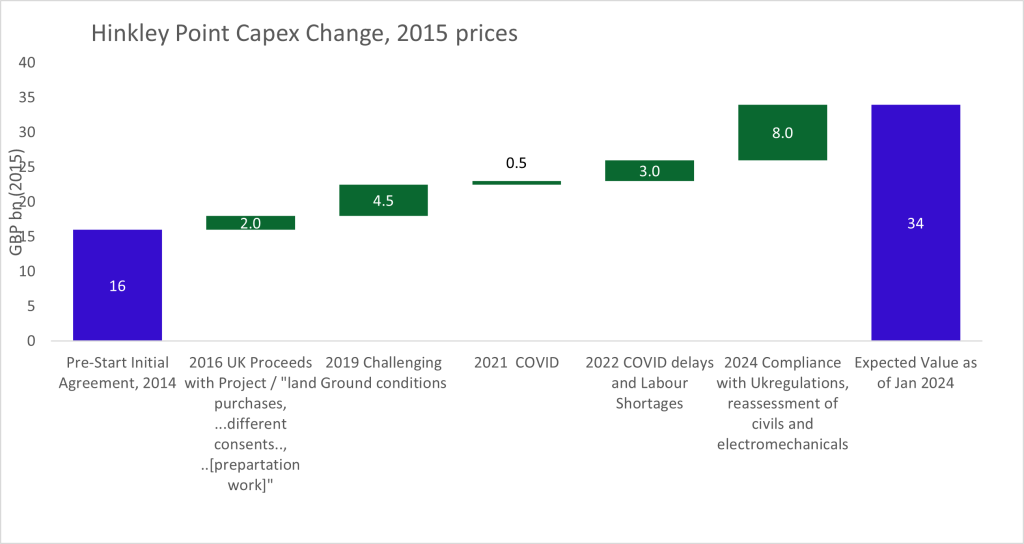The aim of this blog is to line up the reasons of CAPEX increase and current costs estimate for Hinkley Point C (nuclear plant) construction. In general, authors believe that the variety of different technologies in energy mix can support stable energy supply. The authors do not express their own opinion towards either acceptance or rejection of the particular energy generation technology.

EDF (Energie du France) is building a Hinkley Point Cб a large nuclear power station in Somerset, UK. The combined capacity of two reactors is 3.2GW. It uses relatively new technology of EPR – European pressurized reactor. The similar technology is used on two plants in Europe – Flamanville (France) and Olkiluoto (Finland). Neither is yet operational.
In January 2024 it has been widely reported that the cost of construction of Hinkley Point C (HPC) nuclear plant has reached £46bn in nominal terms (£35bn in 2015 prices as reported by EDF Holding Ltd.)[1] with delay to Commercial Operation Date (COD) of around seven years.
We cannot comment on the reasons for the delays as well as increase in the capex. From early initiation the size and complexity of the project attracted attention because various parties were involved. Along with technical and construction difficulties of such enormous project there is a lot of politics around. Those included from French unions to Chinese government enterprise, which is a share holder in the project. A lot of change was brough by unaccounted uncertainties such as Brexit and Covid which both have their own either explicit or subtle impact on the project.
We decided to dive into what have been reported and understand where the increases coming from and what is the expected costs of HPC construction now.
First of all, EDF Holding Ltd is reporting cost of HPC construction in its annual reports under the section “Nuclear New Build”. Most of the times they report the expected CAPEX in 2015 prices but in some years, they show how expected amounts in Nominal prices. It has been also reported how much was spent to date in real (i.e. 2015) and nominal (current) values.
For us it is important to understand 1) what causes cost increases 2) how big was the increases.
In the annual reports EDF commented on CapEx. The first big increase was in 2019 when “challenging ground conditions” forced EDF to increase capex by £4.5bn which is 25% of initial capex of £18bn. Then COVID related delays and disruption to the supply chain added another £3.5bn (19.4%) to the costs[2],[3]. The latest increase this year of £8bn (44.4%) was due to “technical problems: the complexity of installing electromechanical systems and intricate piping”[4]. As a result, the costs of HPC rose to appr. £34 bn (£31-£35bn depending on the scenario) in 2015 prices.
If we assumed that since 2015 to 2023 the CPI increased by 29% the additional inflation increase on the amount which is left to be paid is not less than £4.3bn. Most probably it would be even higher.

It has to be taken to the account that the prices are not fixed and will continue to change with the inflation further as long as project will be in construction mode. As of January 2024, the incurred inflation increase on the project was already £3.9 bn (i.e. in 2015 prices the spent was £18.9bn but actual cash paid £22.8bn).

Almost each of those increases was accompanied with the postponement of COD. Since the start of the project COD has moved by almost 7 yrs from original date. As of Jan 2024 the construction is assumed to take twice as longer as it was forecasted at the start of the project.

To our opinion, the main lessons learnt for such project is when you do budgeting and forecasting – be sure that you have at least as double money to spend on the project as well as it will last at least twice as longer. But it might be learnt from Olkilioto-3?…[5]
[1] Jack S. (2024) “Hinkley C: UK nuclear plant price tag could rocket by a third”, BBC, Accessed 21 July 2024, https://www.bbc.co.uk/news/business-68073279
[2] Ambrose J (2019) “Hinkley Point nuclear plant building costs rise by up to £2.9bn”, 25 September Guadian, Accessed on 20 July 2024 https://www.theguardian.com/uk-news/2019/sep/25/hinkley-point-nuclear-plant-to-run-29m-over-budget
[3] BBC (2022), “Hinkley Point C delayed by a year as cost goes up by £3bn”, 20 May, Accessed on 18 July 2024, https://www.bbc.co.uk/news/uk-england-somerset-61519609
[4] FT 2024, “Why are nuclear power projects so challenging?” Millard R. Tauschinski J, February 1, Accessed on 18 Jul 2024 https://www.ft.com/content/6d371375-b7be-4228-a3d5-2ad74f91454a
[5] WNISR (2025) “Europe’s First EPR: 13 Years Behind Schedule, Olkiluoto‑3 in Finland Starts Up”, Accessed on 22 Jul 2024, https://www.worldnuclearreport.org/Europe-s-First-EPR-13-Years-Behind-Schedule-Olkiluoto-3-in-Finland-Starts-Up.html

Leave a Reply